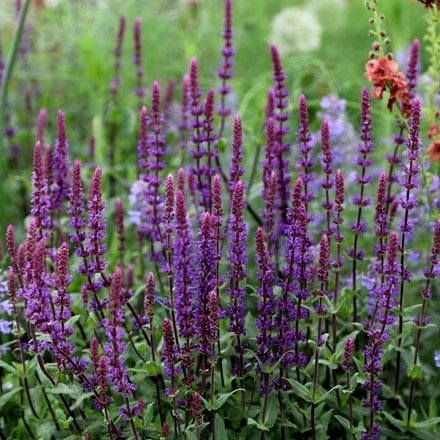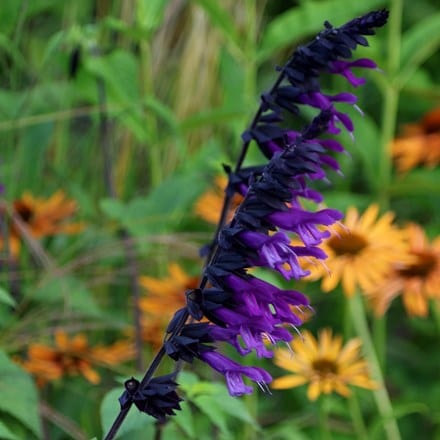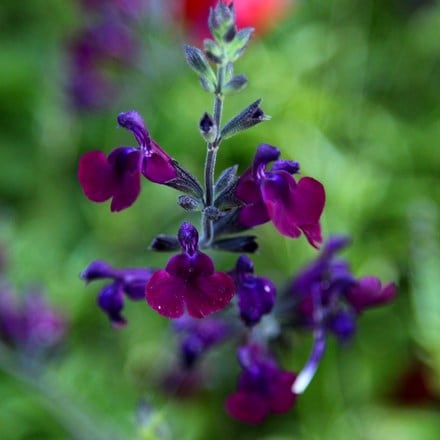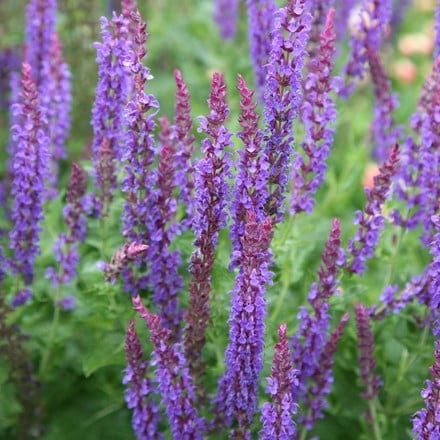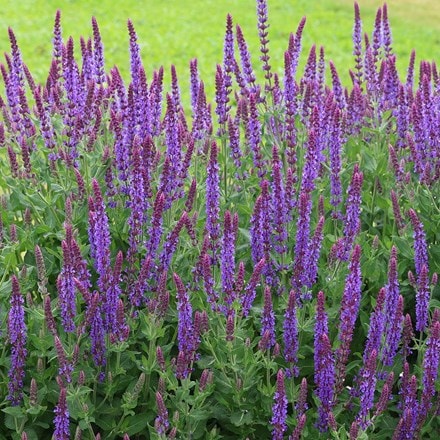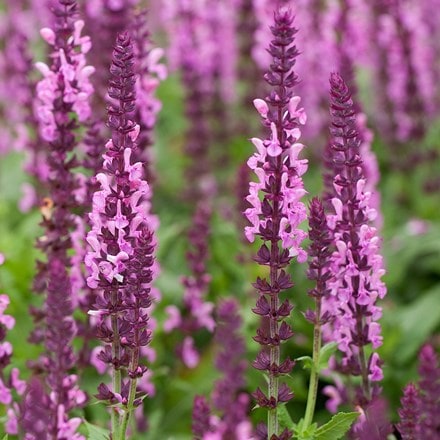
Written by: Ashley Edwards
Discover the different types of salvia – from annuals to perennials and tender varieties – and how to grow them for vibrant, pollinator-friendly colour from summer to frost.


Salvia are a group of plants in the mint family, identifiable by their square stems and opposite leaves. The flowers are often held in spikes, but can also form delicate sprays and they have a distinctive upper and lower lip. The leaves are usually fragrant and range in colour and textures, from smooth and glaucous to grey and hairy. Saliva come from the Mediterranean and South America and will thrive in sunny open positions with free draining soil. If you have clay, or wet soil, consider growing them in pots instead. They are excellent for late summer colour and many will flower through to the first frosts. In some areas of London, I've seen Salvia ‘Hot Lips’ flowering throughout winter!
Salvias come in a range of different forms and colours and knowing the difference will help to choose the right plant for you:


Annual & Biennial Salvia
These are generally used as container plants or to fill gaps in borders. Mixed with other annuals they can give a display throughout the summer. Dead head regularly to keep them flowering and feed with a liquid fertiliser. They will most likely die in the winter frost, so pull them out once they’ve perished. Salvia viridis has beautifully veined bracts and is great as a cut flower, it grows easily from spring sown seeds indoors.


Perennial Salvia
These have a long season of interest, with flowers lasting long into autumn/winter. In the winter leave the dead stems as it helps to protect the roots of the plant from the winter wet. When new shoots appear in early spring, you can cut the saliva back to 20-30cm, this will keep it looking bushy and productive.
Salvia ‘Caradonna’ is a classic in this group and works well at the front of borders and mixed with grasses. The purple flower spikes will appear throughout summer if you deadhead regularly. If the plant stops producing flower spikes, you can cut it to ground level in mid-summer to encourage another flush of flowers. Mulch in spring or autumn with an organic garden compost. Established plants can be dug up and divided every 2-3 years to keep the clumps productive.


Tender Salvia
Brilliant for late summer colour, these are best for filling gaps or using in containers. If you have a bright frost free place in your home, you can overwinter these plants and place them back outside again in spring. Another option is to take cuttings in summer, ready to plant out in spring. Salvia ‘Amistad’ is a popular, tall salvia in this group, with dark purple flowers, which will return the following year in the most protected gardens.
Salvia are generally pest and disease free but you may find aphids in spring feeding on new shoots. Blast them off with water and let the ladybirds do the hard work for you. Powdery mildew can affect saliva if the plant is in poor conditions like shade or damp soil. Cut off any affected leaves and give your plant an organic liquid feed or mulch. Choose a sunny spot with plenty of air movement for your salvia.
Salvias look fab in exotic borders against dramatic foliage plants and also lend themselves well to prairie style planting. They look graceful when paired with late flowering grasses like miscanthus, stipa and clamagrostis. The care and growing conditions are also similar, with both groups of plants enjoying open, sunny areas with well drained soil.
There’s such a huge range of salvia species and cultivars, they are absolutely worth making space for in your garden and are a plant that just keeps on giving.
One plant, three styles featuring Salvia × sylvestris 'Mainacht'

Written by: Plant Doctor, Helen Derrin
It may be relatively compact in stature, but the slender flower spikes make Salvia ‘Mainacht’ a big shot in the summer display. Equally good in pots or borders, it offers a vibrant hit of colour, as well as that all-important structure and vertical interest - which are the things that can transform a planting scheme from wishy-washy to wow!
Soft & subtle (and a magnet for bees)
The salvia adds definition to the softly billowing mounds of the catmint, and contrast to the button-like heads of the astrantia. These three plants will look great together in a naturalised setting, and their nectar (or pollen) rich flowers will also help sustain bees and other pollinators that are looking for their next fix.
Rich & brooding salvia combination
Rich plums and purples always look lavish, and there’s no doubt that they add a degree of intensity to the planting scheme. I love the way the tones of both the iris and the penstemon mirror the salvia, but each offers a different complexity - with the iris it’s a flare of orange and with the penstemon, near-black.
Bright and colourful salvia combination
Get ready to dazzle with these sun-lovers. The salvia and achillea are along similar lines tonally, but when the geum (which is at the opposite end of the colour wheel) is thrown into the mix, everything suddenly intensifies. They’re sublime in summer - particularly when hit by a low sun.







